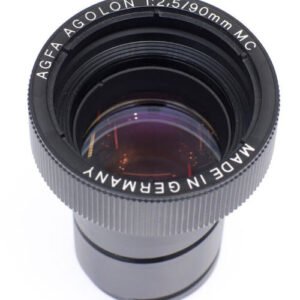| Weight | 218 g |
|---|---|
| Dimensions | 90 mm |
| Focal Length (mm) | |
| Max Aperture (f) | |
| Aperture Blades | |
| Elements | |
| Image Circle (mm) | |
| Front Thread | |
| Rear Mount |
Rollei AV-Apogon 90/2.4
Premium black metal barrel HFT multicoated lens for Rolleivision 330P/ 535P 35mm slide projectors.
Category: Slide Film
Tags: 2.4, 90mm, apogon, av-av-apogon, f2.4, lens, projector, rollei, slide
Reviews
Add a review Cancel reply
Related to . . .
Related products
-

Agfa Color-Agolon 90/2.5
Compare -

Agfa Color-Agolar 60/2.8
Compare -

Agfa Agomar 70-120/2.8
Compare -

Aldis Tele-Projection 250/3.5
Compare -

Benoist Berthiot 90/2.5
Compare -

Aldis Uno 200/4.5
Compare -

Ansco 127/3.5
Compare -
 SOFT
SOFTAgfa Agomar 90/2.8
CompareSOFT -

Agfa Agolon 90/2.5
Compare -

Pentacon AV 150/2.8
Compare -

Benoist Berthiot 60/1.6
Compare -

Aldis Projection 100/3.2
Compare -

Benoist Berthiot 75/2.8
Compare -

Bell & Howell Trionar 127/4
Compare -

Agfa Variomar 80-125/3.1
Compare -

Airequipt Luminac 100/3.5
Compare -

Aldis Anastigmat 85/2.5 [V1]
Compare -

Apollo 90/2.8
Compare -

Agfa Agomar 85/2.8 [V4]
Compare -

Agfa Agolar 85/2.5
Compare -

Argus Projection Anastigmat 100/3.3
Compare -

Pentacon AV 200/4
Compare -

Agfa Agomar 85-150/4
Compare -

Agfa Agomar 150/2.8 [V2]
Compare -

Argus Projection 100/3.5
Compare











16:9 –
As the Super ColorPlan is to the Leica range, so this optic is the ne plus ultra of Rollei’s slide projector lenses – benefiting from HFT multicoating and a name raising hopes of apochromatic rendition. Sadly – as a taking lens – those expectations are dashed in one respect: it suffers from colour fringing to a degree that among conventional lenses would be described as ‘severe’, but which among projector lenses is actually ‘better than average’.
That said, the specimen pictured above rose to the top of DELTA’s ranking of slide projector lenses, and was jointly crowned ‘King of the PJs’, matching the Leica Super ColorPlan P2, and outperforming the best Carl Zeiss, Schneider, Isco, Rodenstock, Docter, Braun and Agfa offerings – as well as its lesser siblings. Largely this is due to truly outstanding centre frame performance. Amazingly, this is a lens you can subject to the withering scrutiny of a 3.3 micron Micro FourThirds sensor, and still enjoy. In Zone A, the AV-Apogon is, by a considerable margin (0.5 points on our sharpness scale) the highest-resolving slide projector lens so far tested – sharper than many modern taking lenses at f2.4.
Unusually, it’s very consistent at all working distances, too. However – despite giving us a fair Zone B – its Zone C performance dips like any slide projector lens – falling from 9.05 to 7.6, placing it among the higher echelons of projector optics: not quite as aberration-free here as the top Leica, and distinctly sub-standard relative to fast modern primes, which comfortably exceed 8.0 at f2.4: the best nearly reach 9.0.
Its drawing style is a little less ‘classically attractive’ – or, if you prefer, ‘more characterful’. There is very faint highlight outlining and a little more mechanical vignetting (cat-eye and swirl) than would be ideal, but colour rendition is deep and saturated, and flare-control (aided by the deep integral hood) is at least as good as any taking lens of this period. Bokeh in general is a little busier than the best of this group (P-Sonnar and Leica Super-CP) but still worthy of a place at the top table.
For sub-full-frame sensors, then, this is probably the best slide projector lens made – it’s by far the sharpest – but although DELTA has garlanded this impressive optic with the highest honours, the point of using projector lenses is not to pixel-peep, but to obtain a certain plasticity: a look, style, or tone of voice. In this regard, the AV-Apogon 90/2.4 is excellent, but not memorable, or unique – in the manner of certain similar, but lowlier, lenses such as the Agfa Color-Agolon 90/2.5.
For GFX, this is an even more valuable lens. More probing scrutiny reveals the AV-Apogon to have stronger resolution across the frame than the Leica Super-Colorplan, partly by virtue of its larger image circle. Bokeh is certainly acceptably smooth, and by comparison with most projector lenses, it excels. It doesn’t have quite the ultimate smoothness of its Leica nemesis, but its in-focus rendering is cleaner and it’s slightly punchier in terms of color and contrast. Both lenses are first-class short GFX portrait lenses – technically superior to the best Isco/Schneider projector lenses that have a more characterful drawing style and slightly more exciting maximum apertures.